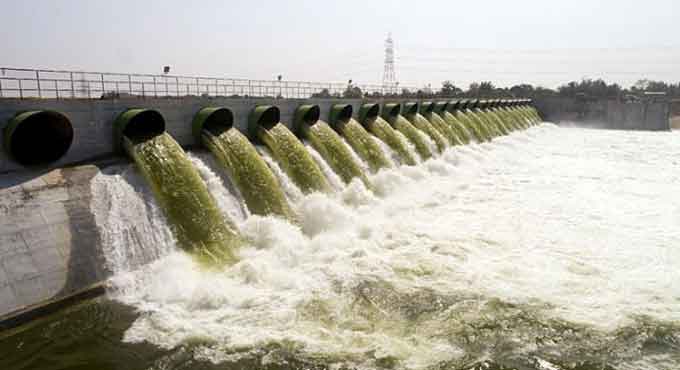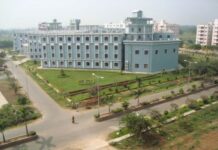The Kaleshwaram Lift Irrigation Project (KLIP) is the world’s largest multi-stage lift irrigation project, lifting river water from 100 meters at Medigadda Barrage (Lakshmi Barrage) to over 600 meters.
Within KLIP, structures like the Medigadda Barrage and the Kannepalli pump house play vital roles and the recent damage to a portion of the Medigadda Barrage has raised a few concerns.
L&T group built the Lakshmi Barrage in 2019, which has been operational since then.
An official spokesperson for L&T on Sunday explained that at one location in Block-7 of the Medigadda Barrage, appeared to be sagging after a loud noise was heard on Saturday evening. L&T further stated that their technical experts have already been dispatched to the project site to assess the immediate cause of the damages in collaboration with state authorities.
Medigadda Barrage was able to withstand unprecedented floods where floodwaters reaching 28.70 lakh cusecs had flowed in, which were exceeding the designed discharge of 28.25 lakhcusecs in July 2022. Despite this, the barrage continued to operate safely. L&T initially constructed the 1.632 kms LakshmiBarrage with 86 piers in 2019, and it has remained in operation since then.
The spokesperson emphasized that the barrage has endured floods, including the recent 2023 flood season. The spokesperson also stated that there was no danger to the project and they have begun draining the flood waters at the barrage so as to ascertain the extent of damage to the pillars.
Reports suggest that if the River Godavari doesn’t flood and solely depends on Pranahitha water, the damage to the barrage would have been severe, but in the past two years with increased Godavari floods and no reliance on Pranahitha, losses were minimal.
Understanding KLIP operations
The region where the KLIP operates has abundant water from the Godavari, while the same level of water availability may not be present upstream.
The Kaleswaram project is designed to facilitate the lifting of 160 thousand million cubic feet (TMC) of water annually, at the rate of 2 TMC per day.
The Lakshmi Barrage is strategically positioned at the inception of the project, just downstream from the confluence of the Pranahita River, which ensures a minimum assured flow of 300 thousand million cubic feet (TMC) of water.
The first component, known as the Lakshmi Barrage is the first component in the project which is responsible for the water lifting operation from this point in conjunction with the LakshmiPump House.
Moving upstream along the Godavari River, the SaraswatiBarrage is the second structure, and the Saraswati Pump House is tasked with the responsibility of water lifting from this location.
Subsequently, the system includes the Parvathi Pump House, which channels water to the long-standing Sripadasagar-Yellampalli Reservoir. From this reservoir, water flows to the Gayatri Pump House, through tunnels located underground.
Parvathi, Saraswathi, and Lakshmi are the newly constructed barrages, each with a daily water lifting capacity of two thousand million cubic feet (TMC).
Till the repair works are completed the water lifting from Lakshmi Barrage has been temporarily halted, however the other pump houses will continue their operations uninterrupted.
Lakshmi Barrage & KLIP Highlights
The 1.6 km barrage with a storage capacity of 16.17 TMC of water will irrigate thousands of hectares of land and provide water to the city of Hyderabad.
The barrage is equipped with 85 Hydro Mechanical Radial Gates fixed between the gigantic concrete piers that are 110 m in length, 4 m / 6 m in width, and 25 m in height.
The concrete used for construction was equivalent to build 7 Burj Khalifas , steel used was equivalent to building 15 Eiffel Towers and earth excavated for 6 pyramids of Giza!
The team set a world record by pouring 25,584 cum concrete in 72 hours!
The KLIP is a multi-purpose irrigation project on the Godavari and is the world’s largest multi-stage lift irrigation project.
Its farthest upstream influence is at the confluence of the Pranahita and Godavari rivers.
Pranahita is a union of smaller tributaries including the Wardha, Painganga, and Wainganga rivers which combine to form the seventh-largest drainage basin on the subcontinent, with an estimated annual discharge of more than 6,427,900 acre-feet (7,930 cubic hectometres) or 280 TMC. As its course is mainly through dense forests and other ecologically sensitive zones such as wildlife sanctuaries, its potential could not be tapped.
The KLIP is divided into 7 links and 28 packages spanning a distance of approximately 500 km (310 mi) through 13 districts and utilizing a canal network of more than 1,800 km (1,100 mi).
The project aims to produce a total of 240 TMC (195 from Medigadda Barrage, 20 from Sripada Yellampalli project, and 25 from groundwater), of which 169 has been allocated for irrigation, 30 for Hyderabad municipal water, 16 for miscellaneous industrial uses and 10 for drinking water in nearby villages, with the remainder being estimated evaporation loss.
The project aims at increasing the total cultivable command area (the sustainable area which can be irrigated after accounting for both upstream and downstream factors) by 1,825,000 acre ft (2,251 hm3) across all 13 districts in addition to stabilizing the existing CCA.
Four major pumping facilities manage the project’s outflow, the largest at Ramadugu (Medaram, Annaram, and Sundilla being the others) is also likely to be the largest in Asia once consistent measurements are available, requiring seven 140 MWh (500 GJ) pumps designed and manufactured specifically for the project by the BHEL. The Engineering giant Megha Engineering and Infrastructures Limited built 15 of 22 Pump houses and undertook a major part of the project.








